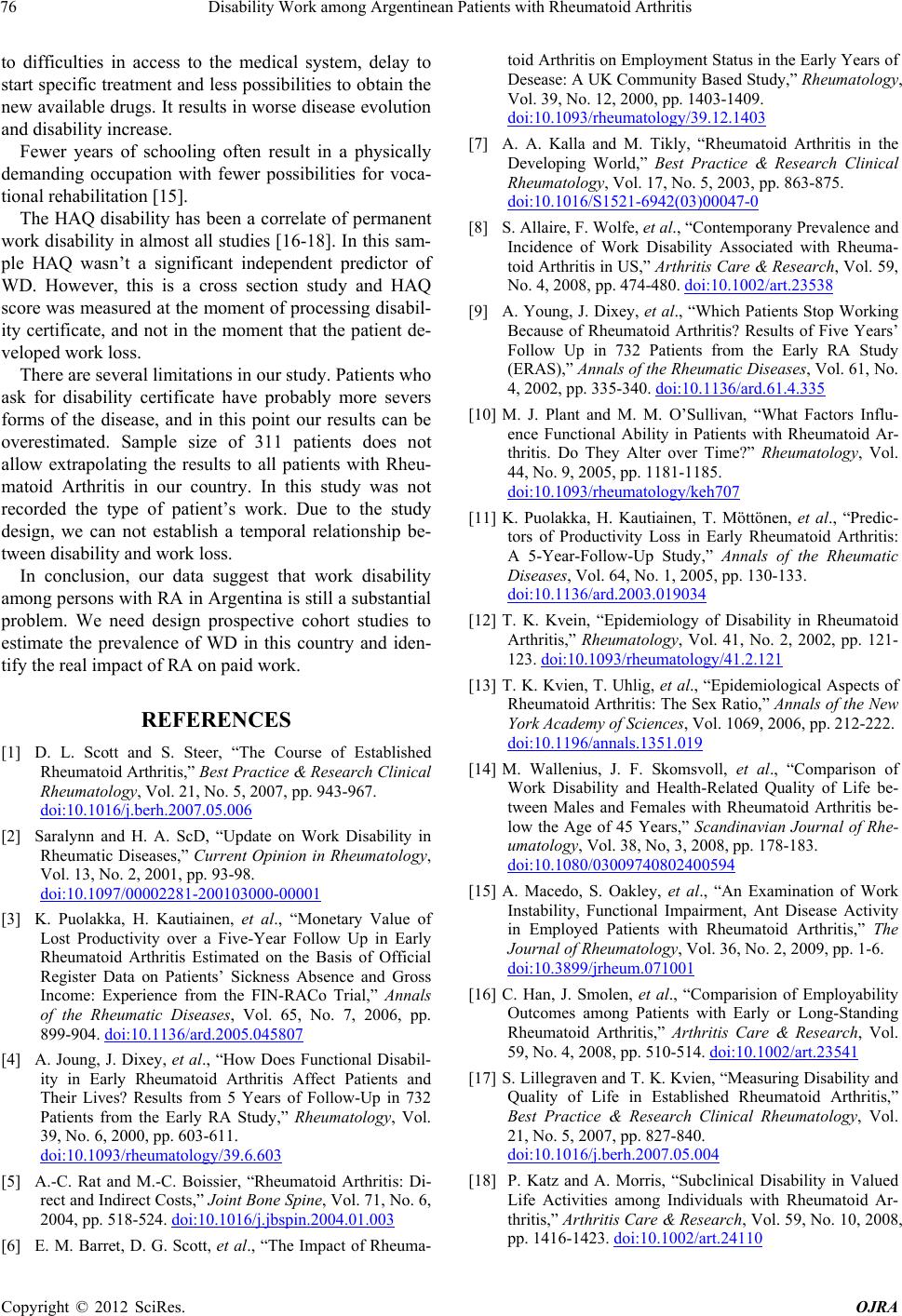
Disability Work among Argentinean Patients with Rheumatoid Arthritis
76
to difficulties in access to the medical system, delay to
start specific treatment and less possibilities to obtain the
new available drugs. It results in worse disease evolution
and disability increase.
Fewer years of schooling often result in a physically
demanding occupation with fewer possibilities for voca-
tional rehabilitatio n [15].
The HAQ disability has been a correlate of permanent
work disability in almost all studies [16-18]. In this sam-
ple HAQ wasn’t a significant independent predictor of
WD. However, this is a cross section study and HAQ
score was measured at the moment of processing disabil-
ity certificate, and not in the moment that the patient de-
veloped work loss.
There are several limitations in our study. Patients who
ask for disability certificate have probably more severs
forms of the disease, and in this point our results can be
overestimated. Sample size of 311 patients does not
allow extrapolating the results to all patients with Rheu-
matoid Arthritis in our country. In this study was not
recorded the type of patient’s work. Due to the study
design, we can not establish a temporal relationship be-
tween disability and work loss.
In conclusion, our data suggest that work disability
among persons with RA in Argentina is still a substantial
problem. We need design prospective cohort studies to
estimate the prevalence of WD in this country and iden-
tify the real impact of RA on paid work.
REFERENCES
[1] D. L. Scott and S. Steer, “The Course of Established
Rheumatoid Arthritis,” Best Practice & Research Clinical
Rheumatology, Vol. 21, No. 5, 2007, pp. 943-967.
doi:10.1016/j.berh.2007.05.006
[2] Saralynn and H. A. ScD, “Update on Work Disability in
Rheumatic Diseases,” Current Opinion in Rheumatology,
Vol. 13, No. 2, 2001, pp. 93-98.
doi:10.1097/00002281-200103000-00001
[3] K. Puolakka, H. Kautiainen, et al., “Monetary Value of
Lost Productivity over a Five-Year Follow Up in Early
Rheumatoid Arthritis Estimated on the Basis of Official
Register Data on Patients’ Sickness Absence and Gross
Income: Experience from the FIN-RACo Trial,” Annals
of the Rheumatic Diseases, Vol. 65, No. 7, 2006, pp.
899-904. doi:10.1136/ard.2005.045807
[4] A. Joung, J. Dixey, et al., “How Does Functional Disabil-
ity in Early Rheumatoid Arthritis Affect Patients and
Their Lives? Results from 5 Years of Follow-Up in 732
Patients from the Early RA Study,” Rheumatology, Vol.
39, No. 6, 2000, pp. 603-611.
doi:10.1093/rheumatology/39.6.603
[5] A.-C. Rat and M.-C. Boissier, “Rheumatoid Arthritis: Di-
rect and Indirect Costs,” Joint Bone Spine, Vol. 71, No. 6,
2004, pp. 518-524. doi:10.1016/j.jbspin.2004.01.003
[6] E. M. Barret, D. G. Scott, et al., “The Impact of Rheuma-
toid Arthritis on Employment Status in the Early Years of
Desease: A UK Community Based Study,” Rheumatology,
Vol. 39, No. 12, 2000, pp. 1403-1409.
doi:10.1093/rheumatology/39.12.1403
[7] A. A. Kalla and M. Tikly, “Rheumatoid Arthritis in the
Developing World,” Best Practice & Research Clinical
Rheumatology, Vol. 17, No. 5, 2003, pp. 863-875.
doi:10.1016/S1521-6942(03)00047-0
[8] S. Allaire, F. Wolfe, et al., “Contemporany Prevalence and
Incidence of Work Disability Associated with Rheuma-
toid Arthritis in US,” Arthritis Care & Research, Vol. 59,
No. 4, 2008, pp. 474-480. doi:10.1002/art.23538
[9] A. Young, J. Dixey, et al., “Which Patients Stop Working
Because of Rheumatoid Arthritis? Results of Five Years’
Follow Up in 732 Patients from the Early RA Study
(ERAS),” Annals of the Rheumatic Diseases, Vol. 61, No.
4, 2002, pp. 335-340. doi:10.1136/ard.61.4.335
[10] M. J. Plant and M. M. O’Sullivan, “What Factors Influ-
ence Functional Ability in Patients with Rheumatoid Ar-
thritis. Do They Alter over Time?” Rheumatology, Vol.
44, No. 9, 2005, pp. 1181-1185.
doi:10.1093/rheumatology/keh707
[11] K. Puolakka, H. Kautiainen, T. Möttönen, et al., “Predic-
tors of Productivity Loss in Early Rheumatoid Arthritis:
A 5-Year-Follow-Up Study,” Annals of the Rheumatic
Diseases, Vol. 64, No. 1, 2005, pp. 130-133.
doi:10.1136/ard.2003.019034
[12] T. K. Kvein, “Epidemiology of Disability in Rheumatoid
Arthritis,” Rheumatology, Vol. 41, No. 2, 2002, pp. 121-
123. doi:10.1093/rheumatology/41.2.121
[13] T. K. Kvien, T. Uhlig, et al., “Epidemiological Aspects of
Rheumatoid Arthritis: The Sex Ratio,” Annals of the New
York Academy of Sciences, Vol. 1069, 2006, pp. 212-222.
doi:10.1196/annals.1351.019
[14] M. Wallenius, J. F. Skomsvoll, et al., “Comparison of
Work Disability and Health-Related Quality of Life be-
tween Males and Females with Rheumatoid Arthritis be-
low the Age of 45 Years,” Scandinavian Journal of Rhe-
umatology, Vol. 38, No, 3, 2008, pp. 178-183.
doi:10.1080/03009740802400594
[15] A. Macedo, S. Oakley, et al., “An Examination of Work
Instability, Functional Impairment, Ant Disease Activity
in Employed Patients with Rheumatoid Arthritis,” The
Journal of Rheumatology, Vol. 36, No. 2, 2009, pp. 1-6.
doi:10.3899/jrheum.071001
[16] C. Han, J. Smolen, et al., “Comparision of Employability
Outcomes among Patients with Early or Long-Standing
Rheumatoid Arthritis,” Arthritis Care & Research, Vol.
59, No. 4, 2008, pp. 510-514. doi:10.1002/art.23541
[17] S. Lillegraven and T. K. Kvien, “Measuring Disability and
Quality of Life in Established Rheumatoid Arthritis,”
Best Practice & Research Clinical Rheumatology, Vol.
21, No. 5, 2007, pp. 827-840.
doi:10.1016/j.berh.2007.05.004
[18] P. Katz and A. Morris, “Subclinical Disability in Valued
Life Activities among Individuals with Rheumatoid Ar-
thritis,” Arthritis Care & Research, Vol. 59, No. 10, 2008,
pp. 1416-1423. doi:10.1002/art.24110
Copyright © 2012 SciRes. OJRA